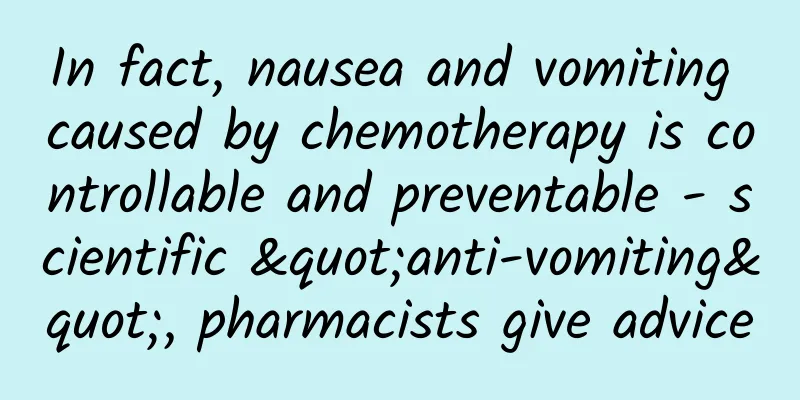In fact, nausea and vomiting caused by chemotherapy is controllable and preventable - scientific "anti-vomiting", pharmacists give advice

|
This is the 4156th article of Da Yi Xiao Hu Clinical pharmacists are often asked 1. Pharmacist, I vomited so much after chemotherapy some time ago that I doubted my life. It was so uncomfortable. Can I not have chemotherapy? 2. It is said that medicine is three-part poison. Taking so many antiemetic drugs must have side effects. I won’t take them anymore. Anyway, I am not vomiting now. I will take them again when I vomit!!! 3. I know dexamethasone. It is obviously a hormone drug. How can it be related to antiemetics? Are you trying to fool me? ? ? Do patients also have a fear of vomiting when facing chemotherapy? Or do they have all kinds of doubts and confusions about chemotherapy antiemetic treatment? Next, the clinical pharmacist will show you a comprehensive understanding of chemotherapy-induced nausea and vomiting and how to scientifically "resist vomiting". Chemotherapy-induced nausea and vomiting (CINV) is one of the most common and most feared adverse reactions in cancer patients during chemotherapy. If medication to prevent vomiting is not given, 70%-80% of patients will experience nausea and vomiting, which can cause anorexia, malnutrition, dehydration, electrolyte imbalance, etc., seriously affecting the patient's quality of life, and even causing the patient to resist chemotherapy and interrupt treatment, leading to disease progression. Why does chemotherapy cause nausea and vomiting? CINV mechanism Vomiting is a multi-step reflex process controlled by the brain. Chemotherapy drugs directly stimulate the gastrointestinal tract, or act on the vomiting center in the medulla oblongata and stimulate emetic chemoreceptors. In some patients, vomiting is also related to past experience and psychological factors. Chemotherapy can lead to the release of multiple neurotransmitters (mainly 5-hydroxytryptamine, substance P, and dopamine) in peripheral and central pathways, stimulating the gastrointestinal tract and brain to produce nausea and vomiting. Therefore, the preventive use of relevant neurotransmitter receptor antagonists in clinical practice is a routine treatment method for preventing nausea and vomiting before chemotherapy. Chemotherapy can cause different types of nausea and vomiting Many patients believe that nausea and vomiting caused by chemotherapy will only occur during chemotherapy. In fact, nausea and vomiting caused by chemotherapy can occur at different time periods, before, during, and after chemotherapy. According to the time of occurrence and treatment effect, it can usually be divided into the following 5 types. Anticipatory nausea and vomiting It refers to the nausea and vomiting that occurs before receiving chemotherapy. Its occurrence is often related to previous unpleasant experiences with chemotherapy. It is a conditioned reflex, mainly caused by mental, psychological and other factors. Acute nausea and vomiting It occurs within 24 hours of administration of chemotherapy drugs, generally a few minutes to a few hours after administration, and reaches a peak 5 to 6 hours after administration, but usually resolves within 24 hours. Delayed nausea and vomiting It occurs 24 hours after administration of chemotherapy drugs, reaches its peak 48 to 72 hours after administration, and can last for 6 to 7 days. Explosive nausea and vomiting It refers to nausea and vomiting and/or the need for rescue antiemetic therapy despite adequate use of drugs to prevent nausea and vomiting. It can occur at any time after the administration of chemotherapy drugs. Refractory nausea and vomiting It refers to the failure of preventive and/or rescue antiemetic treatment in previous chemotherapy cycles, but nausea and vomiting still occur in subsequent chemotherapy cycles. Which chemotherapy drugs are likely to cause nausea and vomiting? Because each patient chooses a different chemotherapy regimen, different chemotherapy drugs cause different degrees of nausea and vomiting, which can be divided into high, moderate, low, and mild. The higher the level, the more likely it is to experience nausea and vomiting after using the drug. For example, the risk of vomiting caused by the platinum drug cisplatin is high, that is, the incidence of nausea and vomiting caused by the use of cisplatin is greater than 90%. If you want to see the emetic risk of other commonly used chemotherapy drugs, please click on the table below~ What are the commonly used antiemetic drugs for chemotherapy? At present, commonly used antiemetic drugs in clinical practice are roughly divided into 5-HT3 receptor antagonists (setrons), NK-1 receptor antagonists (pitants), glucocorticoids, atypical antipsychotics, benzodiazepines, phenothiazines and other types of antiemetic drugs according to their mechanism of action. In clinical practice, depending on the risk of vomiting caused by chemotherapy drugs, a single drug or a combination of antiemetic drugs with multiple mechanisms is selected for use, which is often called a dual, triple or even quadruple drug. There are many types of antiemetic drugs, so let's look at the table... Don’t be fooled by the many adverse reactions that follow, but most of the adverse reactions of antiemetic drugs are mild and can be prevented and controlled~ Which groups of people are more likely to experience nausea and vomiting? In addition to chemotherapy factors, chemotherapy nausea and vomiting are also related to each person's personal constitution, other diseases and concomitant treatments. If one or more of the following conditions exist, the probability of nausea and vomiting will increase~ How to prevent nausea and vomiting? Prevention! Prevention! Prevention! The principle of treatment for chemotherapy-induced nausea and vomiting should be prevention first. Antiemetic treatment should be given priority before anti-tumor treatment. It is not the case that you should eat after vomiting or not eat if you don't vomit. Because once nausea and vomiting occur, it is difficult to control, and it is easy to have anticipatory nausea and vomiting. Therefore, you must take the medicine according to the doctor's instructions. The specific prevention plan needs to be formulated according to the vomiting risk of the proposed anti-tumor treatment, the patient's own high-risk factors, and the severity of previous nausea and vomiting. You can leave this issue to the doctor and clinical pharmacist for evaluation. In addition to taking anti-nausea medication, what should cancer patients do in their daily lives? Diet Adjust the diet structure, eat and drink in small amounts and frequently, avoid irritating foods and foods that are difficult to digest, and focus on high-calorie, high-protein, low-fat, vitamin-rich, easily digestible liquid or semi-liquid diets. Sports Moderate aerobic exercise such as jogging, walking, brisk walking, etc. is encouraged, which can help increase appetite and relieve uncomfortable symptoms such as nausea and vomiting, but the principle of exercise is to proceed step by step and do it within one's ability. Environmental aspects Keep the room well ventilated and well lit and avoid exposure to bad odors. Psychological aspects Ensure adequate sleep and a good mood, correctly understand and treat the disease, and enhance confidence. Music therapy, muscle relaxation and other behavioral training can be used to relieve nausea and vomiting during chemotherapy. The First Affiliated Hospital of Zhejiang Chinese Medical University Written by: Li Cui Review: Wang Jianping Administration |
>>: Eighteen Ways to Reduce Fever
Recommend
Beware! Bottle feeding may not be as "perfect" as you think
gossip Using a breast pump to extract breast milk...
Symptoms of bacterial vaginosis
Vaginitis is divided into many different types ac...
What are the benefits of millet porridge? Does millet porridge nourish the stomach?
Millet porridge is a healthy food in life. It can...
What is discharged after using Funing suppository?
Funing Suppository is a Chinese patent suppositor...
Can pregnant women eat tilefish?
Tilefish is not a very common edible fish, but it...
What are the harms of having two miscarriages in half a year to the body?
Having two miscarriages in half a year is quite h...
Can I use lemon essential oil during my period?
Essential oils are a favorite choice for modern w...
Don’t want to go to work, no appetite… Suffering from “post-holiday syndrome” again? Here are some tips to help you recover!
We always say that we should be full of energy wh...
Can coffee really help you lose weight? Huaxi doctors answer 6 truths about coffee
Recently, I have been I went to West China Hospit...
The reason why pregnant women have sour teeth
Why do pregnant women have sour teeth? Many peopl...
Hysterectomy lifting consequences
I believe that every woman does not want to have ...
How to treat toothache, small folk remedies for toothache
As the saying goes, toothache is not a disease, b...
What are the nutritional values of gray dates? Characteristics of gray dates
In our lives, people like to add a few dates to p...
Treatment for menstruation that is delayed for 4 days
We all know that female friends have menstruation...









